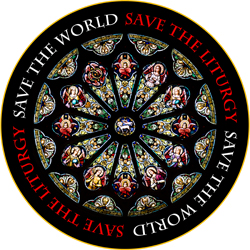St Mary's, at east for the short time I spent in the Twin Cities, and from everything I have heard since had a reputation for executing a rather loosey-goosey litrugy.
Things ARE changing...
Anyway, courtesy Stella Borealis, this is a recent parish bulletin article from Mr von Parys, that ran during Lent:
You will have noticed that we are using a bit more Latin and Gregorian chant in the liturgy during Lent. Some of you are undoubtedly delighted by this and desire even more. Others may be less pleased and would prefer that there were none.
Whether we like it or not, Latin has been the language of the liturgy for some 15 centuries and Gregorian chant has been the musical norm for nearly as long.
The origin of Latin in the Mass goes back to the early centuries of the Church when Christianity became the religion of the Roman Empire. In the Western part of the Empire, commoners did not know Greek, so the original language of the gentile Church (Greek) was replaced with the language of the people: Latin.
Note that the language used for the liturgy in other parts of the Mediterranean was the language spoken by the people of the area. As a result, the liturgy was celebrated in Syriac, Greek, Latin, Coptic, etc. Latin was used long after the empire had collapsed and long after people stopped understanding this original vernacular language of the liturgy.
Despite this “stability” in language in the Roman Rite and although the perception may be completely opposite, the reality is that the liturgy of the Church has never been absolutely static; on the contrary the liturgy has adapted itself to every time and every place. Sometimes this happened in very dramatic ways; at other times, the change was more subtle and hardly perceptible to the untrained eye.
As a result we have a repository of liturgical texts, rituals, art, architecture and music that is extraordinarily rich and diverse. Every generation of Christians has interpreted the time proven ritual in light of the contemporary context. Sometimes this was accompanied by a moment of iconoclasm of sorts when the “old” was thrown out in favor of the “new.” At other times the old was merely adapted and reformatted.
In terms of music we are heirs to an enormous repository of liturgical music composed for use in the Roman Rite over nearly 2000 years. Although not all of it is of the quality that would warrant use in the liturgy today, some of the old favorites surely have their place in today’s celebration and Gregorian chant is part of the latter.
Gregorian chant indeed “is a living connection with our forbears in the faith, the traditional music of the Roman Rite, a sign of communion with the universal Church, a bond of unity among cultures, a means of diverse communities to participate together in song, and a summons to contemplative participation in the liturgy.” (Sing to the Lord, par. 72) Because of this, it is good to use Gregorian chant in the liturgy, albeit with care and moderation.
“Each worshipping community in the United States, including all age groups and all ethnic groups, should at minimum” learn some of the easier chants of the Mass (Sing to the Lord, par. 75). These include the ones that are being used during the Season of Lent.
Let us embrace our Tradition, old and new, learn from it and inspired by it journey to the Easter celebrations.
Is Ray from MN right when he opines, "There seems to be some light at the end of the musical tunnel"?
One can only pray...




No comments:
Post a Comment